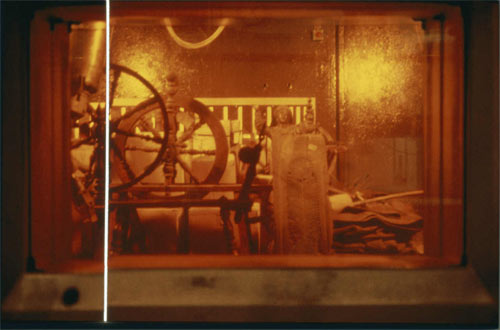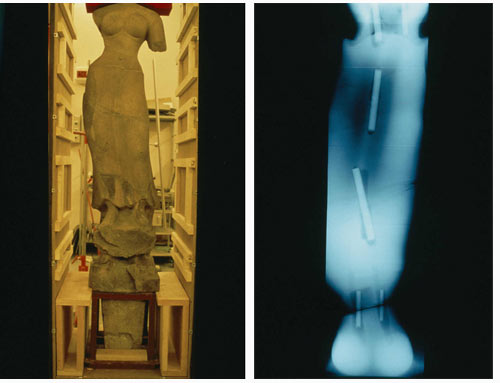Protecting our heritage
Buried underground, trapped in mud, battered by the elements, attacked by insects and microbes, the artefacts that survive the centuries are often considerably worse off for their journey. For those people whose curiosity is aroused, however, all their ingenuity, skill and patience are required to help bring these objects back to life.

Irradiation of ethnographic material
View through a porthole of the irradiation cell of the Art-Nucleart laboratory in Grenoble. In the back, rods of the caesium-60 cell can be seen. The porthole is made of lead glass. This lead glass wall is thick enough to absorb the cobalt-60 gamma rays, allowing to follow without danger the operation. Gauges allow also to follow the amount of irradiation sustained by the objects, their temperature and eventually modify by remote control the source position.
© CEA/Arc-Nucléart
Gamma irradiation is one of the most effective methods used to prevent the further deterioration of historical relics. Exposure to gamma rays not only acts as a powerful disinfectant but also serves to strengthen the structure of the object, halting future physical decay. Using this method, the causes of structural collapse can be avoided and many weak and crumbling pieces can be significantly strengthened.
The uses are clearly manifold in the field of conservation: whether of artistic pieces or of ethnological and anthropological artefacts. Gamma rays can also cause polymerisation in certain plastics, thereby making them harder and more resistant. This is used to great effect when strengthening decayed objects made of wood or stone – they are filled with a liquid resin which is then hardened under gamma ray exposure.
Objects that are found underwater are often most in need of this kind of treatment. Much of the Titanic, which was far too structurally fragile to be lifted out of the water, was exposed to gamma rays to allow for an effective salvage.
Gamma rays are very similar to X-rays in their ability to affect the interior of objects. Despite being even more penetrative, however, gamma rays leave no residual radioactivity in exposed substances.

Gamma radiographies
National french museums and the Musée Guimet of Asiatic Arts in Paris have entrusted in 1997 three precious statuettes of khmer divinities to the CEA department of « Applications des rayonnements ionisants » at Saclay. Gamma rays of cobalt-60 are more penetrating than usual X-rays. They show the inside consolidations of one of the statuettes.
© CEA/Saclay
The insight X- and gamma rays give to the internal structure of objects has made their use widespread in the reconstruction of statues. By using a much weaker dose than is involved in strengthening work, gamma rays allow experts to see into thick and absorbent stone and determine how much work is needed or advisable.